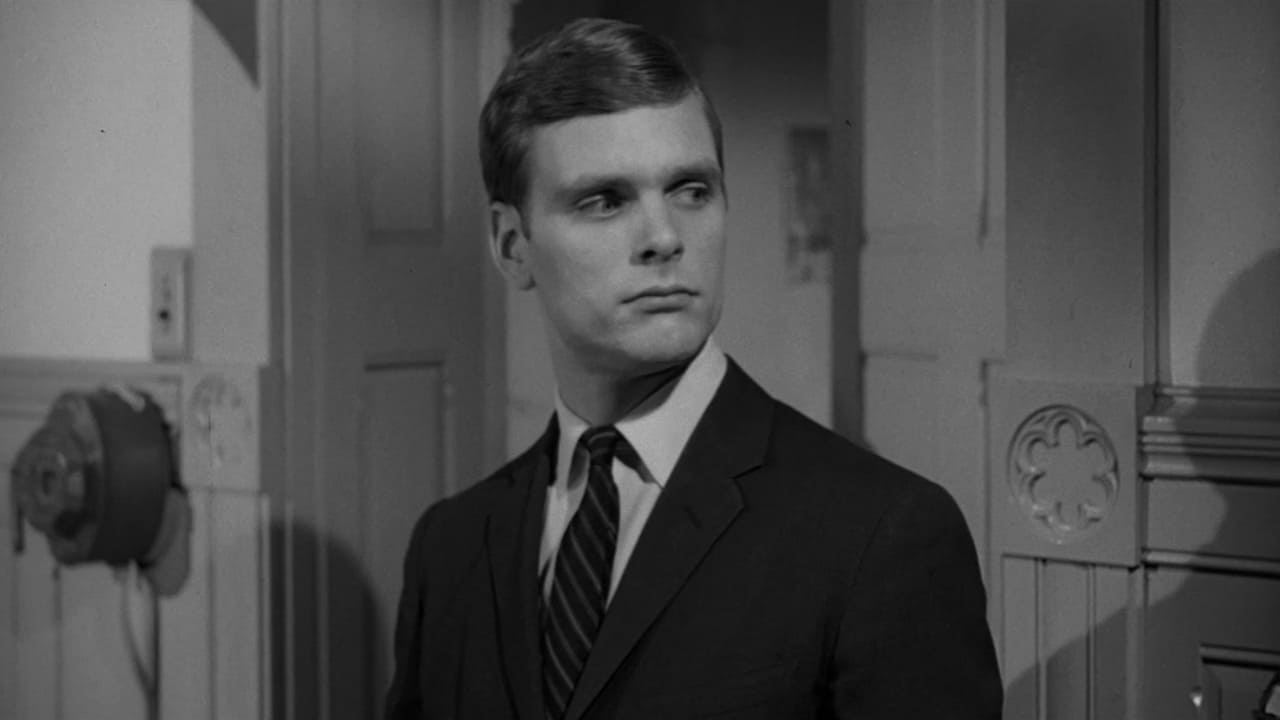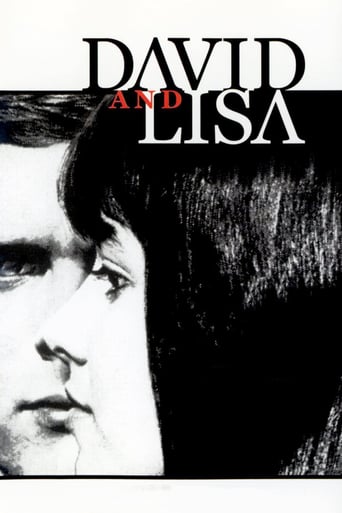

The movie's very un-Hollywoodish nature created considerable buzz at the time of release. Audiences weren't used to a documentary-like approach to such tricky subject matter. Then too, the production team and cast were not exactly household names. I expect the movie's success exceeded the Perry's fondest dreams. Happily, it gave them encouragement to continue independent production of offbeat subjects.The trick here is to have mental illness treated in a detached yet sensitive way. At the same time, David's (Dullea) ice-cold demeanor is not apt to win audience allegiance at the outset. We're never told exactly what his problem is, which is the way it should be, but the severe emotional repression evidently has to do with a cold, unfeeling mother (Patterson). Also, not wanting to be 'touched' looks like a metaphor for keeping his feelings hidden not only from others, but from himself as well. In that difficult role, newcomer Dullea is totally convincing— a handsome, pale-eyed iceberg.As Lisa, the unknown Margolin is wonderfully expressive, her face literally lighting up as David shares her secret language of rhyming. She is so winsome, it's not surprising that even David takes notice. We know less about Lisa than about David, but obviously the statues she embraces represent key absences in her life. When the two finally touch, a moving moment rare for any movie is reached. At the same time, note how the therapist Dr. Swinford (deSilva) is portrayed more as a facilitator than as an analyst. He provides the environment in which the two can reach each other in ways that his expertise cannot. And he's wise enough to know that. I don't know what the Perry's expected from their two principal actors, but what they got is almost sublime, and a big reason why I think audiences responded so enthusiastically. Too bad the film has slipped into obscurity since that initial reception. It certainly deserves rediscovery, especially on TCM.
... View MoreAmerican screenwriter, producer and director Frank Perry's feature film debut which was written by his first wife, American writer Eleanor Perry (1914-1981), is an adaptation of psychiatrist and author Theodore Isaac Rubin's novel "Lisa and David" and an American production which was shot on locations in Philadelphia, Pennsylvania in USA and produced by American film producer Paul M. Heller. It tells the story about David Clemens, a young man with Obsessive-compulsive disorder who after having been brought to a residential treatment centre by his mother and somewhat reluctantly left there in the hands of a doctor, meets a young woman named Lisa Brandt who only expresses herself through rhymes. David takes an interest in Lisa and begins to communicate with her on her conditions. David and Lisa finds a connection, but many obstacles arises when he learns that she has dissociative identity disorder and she learns that he can't stand to be touched by other people.Finely and acutely directed by American filmmaker Frank Perry (1930-1995), this finely tuned independent film from the early 1960s which is narrated from various viewpoints though mostly from the main character's point of view, draws an incisive and humane portrayal of an institutionalized young man's conflicting relationship with his parents and his growing relationship with a shy and charming young woman. While notable for its naturalistic milieu depictions, fine art direction by Paul M. Heller, black-and-white cinematography by American cinematographer Leonard Hirschfield (1928-2008) and use of sound, this character-driven and dialog-driven story which examines themes like coming-of-age, interpersonal communication, mental illness, family relations, friendship and trust, depicts two in-depth studies of character and contains a fine score by American composer and producer Mark Lawrence (1921-1991).This romantic, at times humorous and empathic character piece about the internal struggles of a young man and woman who are striving to learn how to trust one another, is impelled and reinforced by its cogent narrative structure and the prominent acting performances by American actor Keir Dullea in his second feature film role, American actress Janet Margolin (1943-1993) in her debut feature film role and American actor Howard Da Silva (1909-1986). An authentic, illuminating and gripping psychological drama which gained Academy Award nominations for Best Director and Best Adapted Screenplay at the 35th Academy Awards in 1963.
... View MorePoor Mrs. Clemens! One more castrating mom to add to our culture's most wanted list. She's wanted for turning her son, David, into an "obsessive-compulsive." By depriving him of love, pushing him towards success and achievement; by being more dominant than her milk toast husband; by being sexy but asexual, beautiful but cold, she must suffer the hostility of not only her son, but to a lesser extent, her husband, and her son's doctors--add too her son's fellow "inmate," a sex-crazed teenager, who has "knocked up 13 girls," and whose mom is a hooker.Anyway, David is deathly afraid of time and death, and he associates these with his upper class mother. Because she is unfeeling, non-communicative, and non-protective, touch itself can kill him. If he is emotionless, it's because his mother is. If he is totally shut off to the world, than his perfectionist mom's to blame. If he cannot develop, it is, in Freudian fashion, because his mother lords it over his father, thus making David mom-dependent, and his father, David's way into the larger world, "nothing but a marshmallow." So it is that Mrs. Clemens is both ice and earth, remote and engulfing, unloving and clinging--to the boy she gave birth to. It's mother-time and mother-love which make touch terrorizing to David. And his outright expressed hatred of her is viewed by him as a step to healing: "parents don't like you when you're sick, and when your well, either." Mrs. Clemens, simply put, is too much mother, who mothers too little.The true mother is the woman holding her son in the railway station, on the night that David escapes his toxic parents' home. This mother's love is unconditional, sensual, and giving and David claims her as his very own mother. With her as a mom he might in Dr. Swinford's words "take a chance and open up and let love in." Interesting how a scene of blissful maternity can jump start David's recovery.Lisa, his "patient" and dear female friend is also a prop to his wellness. Lisa, unlike David, has no history, no mother to blame for her multiple personalities. She is free-floating, adorable, innocent, child-like (several years younger than David) and earthy in her dark features. She's capable of a kind of psychic communication, rhyme-speech, and expressed intimacy. She is, in other words, a blessing to David. She's a "pearl of a girl," in his words--words that awaken sensual awareness in both--because she is spontaneous and vulnerable and serves as David's inner self or soul. One of her telling rhymes is "rhymes, time, slime" which seems to point to David's second birth, and to herself as one of its mediators.Dr. Swinford or "Alan" to his "students" or "inmates" is another of David's safe mediators. He fathers David's development through a kind of liberal, humanistic, "do your own thing" approach. Any constraint is suspect, and creativity is the ultimate form of therapy at his private institution. He is satisfactory to David despite the fact that he passively absorbs more hostility from him than does his hapless father from his mother. His non-judgmental guidance, in a sense, seems to make him a third female kind of figure in David's recovery, but Dr Swinford, in his professional capacity---he's a psychiatrist and a more convincing father figure whose role and profession he will follow--also serves as model for David's autonomy.That autonomy or rebirth is equivalent to recovery or David's integration into love, authority, and society. This means, above all else, a transcendence of his mother and his worldly birth. But doesn't his rejection of his mother include his rejection of "rhyme, time, slime?" So how will he accept the world without accepting time? Perhaps because he's discovered male time--and male identity (his terror of freak shows and the Geroge/Georgina character). This newly discovered order is controlled, ordered, authorized-- the very stuff that he has abhorred and ridiculed to date, but which now can be viewed differently from a select identity. He has entered Freud's history (the clock is fixed) and left his mother's behind.The towering museum columns between which the final scene is shot is proof of his elevation into manhood. The tall blond young man walks off into the morning Light (why did it take him all night to reach the museum?) having dispelled the darkness, hand and hand with his little brown-eyed girl. Isn't it ironic that in the mutual rescue scene at the museum that it is David who allows Lisa to grasp his hand when--his rejection of her in the piano room is why she escaped and is endangered--she should be allowing him to touch her.
... View MoreThis film is a true gem. I get the impression that it just missed being given an Academy Award nomination for Best Picture. After all, it did get a nomination for Best Director and usually the two go hand in hand. I also feel that both Keir Dullea and Janet Margolin deserved to be nominated for their acting roles in the top category. The whole thing is sublime and sensitive, handling difficult material in a tender way that seems more European than American. I suppose some might call it contrived and deliberately "artistic" to the point of being obnoxious, but it did not rub me that way. I think it stands the test of time.What is memorable to me is the simple beauty of the film. The black and white cinematography is outstanding. The scenes flow naturally. The camera angles and editing are exact and unobtrusive. The actors are given their chance to provide the motion in the picture, rather than the camera constantly panning around. This allows the viewer to focus on the two lead characters without being distracted.
... View More